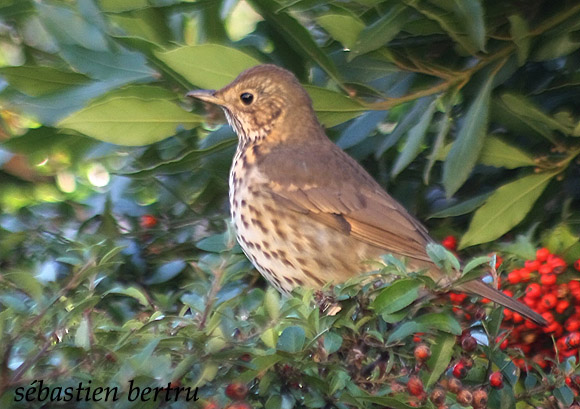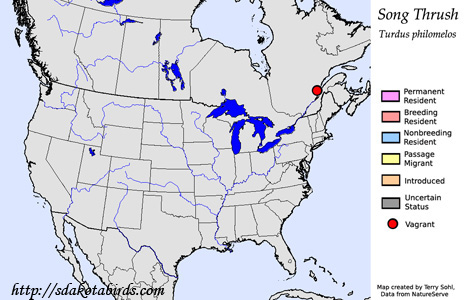| Length: 8.5 inches | Wingspan: 13 inches | Seasonality: Non-resident in South Dakota |
| ID Keys: Brown upperparts, buffy pale underparts with chevron-shaped speckles, pink legs, yellowish bill | ||
 The
Song Thrush is native to the Old World. They breed from the United
Kingdom eastward, through Scandanavia and much of Russia, and in the winter
they are primarily found in western Europe, the Middle East, and northern
Africa. A popular and well known songbird in much of Europe, they have
also been introduced to Australia and New Zealand, where persisting breeding
populations have now been established. In North America, they are
known from but a single sighting. In November of 2006, a single,
first-year bird was found in Saint Fulgence, Quebec. The bird was well
seen and photographed for 2 days before disappearing. The species is a
regular vagrant in Iceland, and a dead Song Thrush was once found in
Greenland, so there's some history of wayward Song Thrush being found far
west of their normal range. However the Quebec sightings remains the
lone North American sighting.
The
Song Thrush is native to the Old World. They breed from the United
Kingdom eastward, through Scandanavia and much of Russia, and in the winter
they are primarily found in western Europe, the Middle East, and northern
Africa. A popular and well known songbird in much of Europe, they have
also been introduced to Australia and New Zealand, where persisting breeding
populations have now been established. In North America, they are
known from but a single sighting. In November of 2006, a single,
first-year bird was found in Saint Fulgence, Quebec. The bird was well
seen and photographed for 2 days before disappearing. The species is a
regular vagrant in Iceland, and a dead Song Thrush was once found in
Greenland, so there's some history of wayward Song Thrush being found far
west of their normal range. However the Quebec sightings remains the
lone North American sighting.
Habitat: Can be found in a variety of woodland, forest, and other vegetated habitats, including forest edges and clearings, forested riparian areas, open woodland, urban parks and gardens, and well-vegetated residential areas.
Diet: Feeds heavily on insects, worms, and other small invertebrates, especially during the summer breeding season. Snails sometimes become a preferred food item. They will also feed on berries and fruits, particularly in the winter months.
Behavior: Much foraging is done on the ground, where they tend to stay near protective vegetation as they search for earthworms, snails, and other prey. They are known for feeding on snails in some locations, grabbing them with their bill and smashing them against a rock or other hard surface to break the shell and gain access to the soft body inside.
Nesting: The nest is a cup built of twigs, lichens, moss, and leaves, lined with bits of wood and bark bound together with the bird's own saliva. The nest is usually placed in a tree or shrub, and may be quite close to the ground or as high as 40 feet. The female lays between 2 and 6 eggs, and she alone incubates them. The young hatch after about 2 weeks, with both parents helping to feed and raise the young. The young fledge about 2 weeks after hatching.
Song: The song is a varied series of musical phrases, repeated multiple times before changing to a new series of phrases.
Migration: In their native Europe and Asia, most birds in the northern parts of their range are migratory, but some populations may be resident year-round, particularly in parts of western Europe. Resident populations may be augmented in the winter by migrating birds from further north.
Interactive eBird map: Click here to access an interactive eBird map of Song Thrush sightings
Similar Species: For any vagrant that may again be found in North America, they are most likely to be confused with the Catharus thrushes, including Swainson's Thrush, Gray-cheeked Thrush, or Hermit Thrush. They could also be confused with a Wood Thrush.
Conservation Status: Song Thrush populations are generally strong and may be increasing at a global level. They are found over a wide geographic area, and are common in parts of their range. There are some regional populations that may be in decline, including populations in the United Kingdom and other parts of Europe, but overall, the IUCN lists the Song Thrush as a species of "Least Concern".
Further Information: 1) BirdLife International - Song Thrush
2) New Zealand Birds Online - Song Thrush
3) First record of Song Thrush (Turdus philomelos) in North America - Sora (2007), Volume 61, Issue 1.
Photo Information: Photo by Sebastien Bertru - Photo licensed under Creative Commons Attribution ShareAlike 2.0 Generic License
| Click below for a higher-resolution map |
 |
| South Dakota Status: Non-resident in South Dakota |
Additional Song Thrush Photos (coming soon!!)
